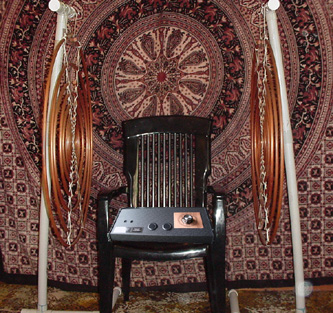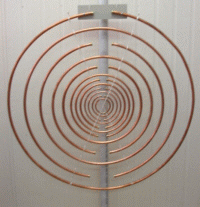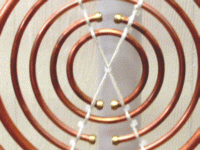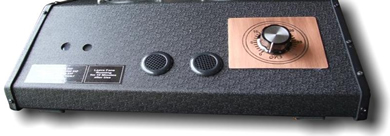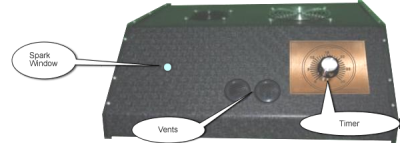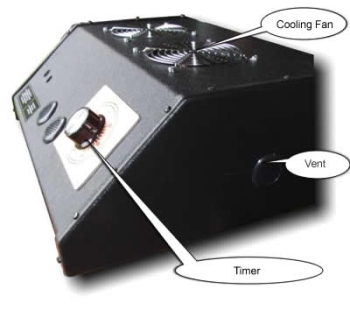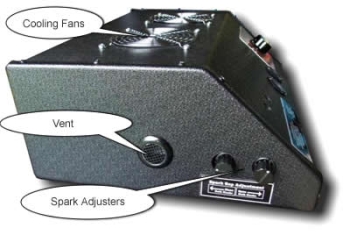Frequency
Analysis of the Lakhovsky Multiple Wave Oscillator
Frequency Analysis of the Lakhovsky Multiple Wave Oscillator
from 20
Hz to 20 GHz
by Toby Grotz & B. Hillstead
U.S. Psychotronics Association Annual Convention (Portland, OR, July 1983)
Spectral Analysis of the Lakhovsy Multiple Wave Oscillator
Abstract ~
The Lakhovsky Multiple wave oscillator (MWO) has been used to treat various disease conditions. The device emits electromagnetic radiations which are directed at a subject requiring treatment. It has been shown that the human body is sensitive to electromagnetic radiation and may be healed or harmed upon exposure to them. It was therefore determined that a spectral analysis of the frequency content of the emanations from a Multiple Wave Oscillator would be of interest and was thus performed.
Background ~
Russian-born Georges Lakhovsky began an investigation into the field of electronic medicine in the 1920s. His book, "The Secret of Life", was published in English in 1939. In 1949 Mark Clement published a reviews of Lakhovsky's work called "Waves That Heal". An excellent review of the literature, studies, experimentation, and plans for construction of an MWO has been published by Borderland Sciences Research Foundation (BSRF).
The frequency spectrum of the MWO has been measured previously. He BSRF publication quotes Clements as stating the oscillator gave "wavelengths from 10 cm to 400 meters".
Since 9(MHz) = meters / 300,
The frequency range would run from 750 KHz to 3 GHz. Bob beck in the same publication reported a bandpass of 15 to 250 MHz. The MWO used in the present study did not, however, interfere with radio or tv reception as previously reported, and has been used in the same room as a television receiver without any interference.
The amplitude versus frequency content of the MWO is an important consideration given in the table of effects by Kleinstein and Dyner as presented in Kaines, "Electromagnetic Field Interactions with the Human Body". If some frequencies of electromagnetic radiation produce deleterious effects and some frequencies promote healing then analysis of the frequency content of the MWO should give clues to its successful usage.
MWO Theory of Operation ~
The MWO is a high voltage transformer. The traditional methods and the one used during this research consists of 12 volt DC power supply amplified and set into oscillation with a Model T Ford spark plug operating at about 400 Hz. The Ford coil is a high voltage transformer with a relay in series with the primary. As soon as the 12 VDC is applied to the primary, a magnetic field is generated in the core pulling in the relay and interrupting power. The result is a series of high voltage spikes at the output of the transformer. The high voltage spikes are fed into a Tesla coil. Tuning is accomplished by varying the tension in the Ford coil relay and by adjusting the spark gap in the Tesla coil circuit. Local atmospheric conditions, primarily humidity temperature, affect the operation of the circuit and retuning is sometimes required.
The spark gap si a study in itself. An adjustable spark gap was developed which is suitable both for the MWO and the Tesla coil enthusiasts. The dynamics of spark gaps and sustained arcing are delineated in the book, "The Electric Arc".
MWO Technical Description ~
The inductance of the Tesla coil in the MWO tested was measured with an Electro Scientific Industries Impedance Meter, Model No. 253 and was found to have a primary inductance of 14.6 uH and a secondary inductance of 3.1 mH. Exciting the primary with a sine wave from an Exact electronics model 504 function generator, and measuring the output with the Tektronikx Model 7313 storage scope and Heathkit Model IM 4100 frequency counter, the maximum output was found at 200 KHz.
Antenna Design ~
The antennas used for MWO operation were fabricated using guidelines established in the BSRF publication. The concentric rings were etched from a copper clad board using standard photo resist methods. Several sets of antennas were made in order to delineate the optimum spacing between rings. The antennas which gave the best arcing pattern when used with each of the six MWOs were chosen for use during the Spectral analysis.
The second antenna used during experimentation was based on the geometry of a mandala known as a flat pyramid. The visual effects and the amount of sparking were significantly enhanced.
Transistorized MWOs ~
Many methods of generating the high voltages required by the MWO may be devised. The Tesla coil kit sold by BNF Enterprises generates sufficient voltage but the frequency of operation is too high. A frequency of 55 KHz with a power consumption of 1 amp is generated when not arcing and in an idle mode. When an arc is drawn, the frequency lowers to a minimum of 250 KHz at an arc length of one inch, while the power supply current increases to 3 amps. The high voltage and frequency generated does not match the MWO Tesla coil and cannot be used to replace the Ford coil in the MWOs used in this study. If the output of this circuit is hooked directly to an antenna, there is sufficient voltage to produce arcing but the copper etching is burned off the antenna at arcing points due to the high frequency generated by the BNF circuit.
A more viable solution to transistorized operation is in the following circuit. This will allow tuning the output frequency and the power level. It may even be feasible to build an MWO without having to hand wind the Tesla coil as described in the BSRF publication.
The Frequency Analysis ~
The electromagnetic radiations of the MWO were tested using computer controlled EMI-RFI equipment. The equipment used was as follows:
(1) Singer Stoddart Model S1700 EMI/RF Data Acquisition System
(2) HP-9845B Computer
(3) Singer Stoddart EMI/RF Intensity Meters NM-7, NM-17/27, NM-37/57
(4) Singer 9217-3 Rod Antenna 14-25 MHz
(5) Singer 93491-1 Log Spiral Antenna 0.1-10 GHz
(6) Electrometrics BIA 25 Antenna 25-100 MHz
Field strength was tested at 1 meter.
The results of the tests from 16 KHz to 10 GHz are shown in the accompanying computer printouts.
The signal strength at 14 KHz was around 140 dB. At 25 MHz the signal had dropped to approximately 120 bB. A subject sitting between the pates would be exposed to a signal level about 10 times stronger than a local broadcast station a this frequency. Five runs of data were printed on top of each other. The plot shows that the MWO has a constant output. This was shown to be true over the entire measured spectrum.
The next run from 25 MHz to 200 MHz was conducted using two different antennas. The pyramid antenna was used along with an improved circular antenna with close ring spacing. The closer spacing on this antenna produces more arcs of a greater diameter. There was no significant difference in output between the two antennas.
The hypothesis that the radiated energy was coming from within the MWO due to the spark gap was tested. Removing the antenna produced no noticeable change and was measured without an antenna attached to the MWO. The run from 1 GHz to 10 GHz was made with and without antenna. Again no difference in output was noted. The data beyond 7 GHz was determined to be faulty, requiring modification of the program parameters.
Conclusion ~
At a later date an analysis will be made from 20 Hz to 14 KHz and from 10 GHz to 20 GHz. The significance of the data recorded at this time can be seen not only in its constant high output of a large range in frequencies, but also in the radiated output without antennas. It may well be that the beneficial effects of MWO usage for various disease conditions is not due to radiation in the electromagnetic spectrum. The electric discharge of the spark gap may generate non-hertzian waves. Tom Bearden has suggested this possibility in describing Tesla's Colorado Springs experiments, and Preston Nichols described this possibility in his description of Marconi's trans-Atlantic broadcasts. Although the reference has not been verified at this time, it is suggested that Tesla considered his longevity and health to be due to frequent exposure to high voltage, high frequency electric discharges. This in effect can be duplicated by use of the Lakhovsky Multiple Wave Oscillator.
Bibliography ~
(1) Borderland Sciences Research Foundation: The Lakhovsky MWO.
(2) Calvin, Melvin, & Gazlenko, Oleg G.: Foundations of Space Biology & Medicine; Joint USA/USSR Publication, Vol. II, Book 2, "Ecological & Physiological Bases of Space Biology & Medicine", Science & Technical Information Office, NASA, Wash. DC, 1975.
(3) Krauss, H.L., et al.: Solid State Radio Engineering; John Whey & Sons, NY, 1980
(4) Raines, Jeremy K." Electromagnetic Field Interactions with the Human Body: Observed Effects & Theories", NASA CR 166661 (1981).
(5) Somerville, J.M.: The Electric Arc; John Wiley & Sons, NY, 1959.
Test Plots ~
 |
 |
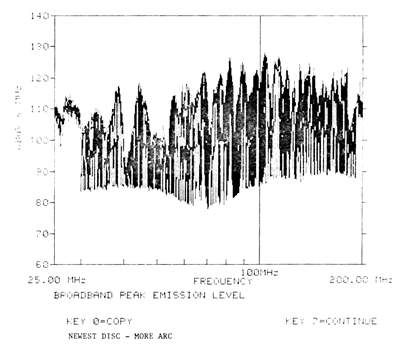 |
 |
 |
 |
 |
